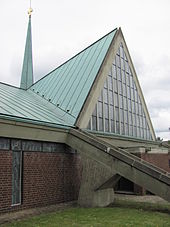Holy Cross Church (Hamburg-Volksdorf)
The Holy Cross Church in Hamburg-Volksdorf is the church of the local Roman Catholic parish of the same name. The parish belonged to the Dean's Office of Hamburg-Nord of the Archdiocese of Hamburg and has been part of the newly established parish “Sel. Johannes Prassek ”.
description
The church is located in the northeast of Hamburg on Farmsener Landstrasse near the Volksdorf underground station. The parish includes 4,200 Catholics (2009) who live in the Hamburg districts of Volksdorf, Bergstedt , Duvenstedt , Lemsahl-Mellingstedt , Wohldorf-Ohlstedt , the north of Farmsen-Berne and the Schleswig-Holstein community of Ammersbek -Hoisbüttel. Due to the eccentric location of the church in the community area, Christians outside the community area, especially in the neighboring Hamburg district of Meiendorf, feel part of the community. The church paths are up to 10 km. Pastor Gerhard Staudt was the parish priest from 1983 to 2014.
As part of the reorganization of the Archdiocese of Hamburg, it became on June 29, 2014 with the neighboring communities Heilig Geist (Farmsen), Mariä Himmelfahrt (Rahlstedt), St. Bernard (Poppenbüttel), St. Wilhelm (Bramfeld) as well as all Catholic institutions and services of this Area to the newly founded parish "Blessed Johannes Prassek".
history
Until April 1937, Volksdorf was a Hamburg exclave in Schleswig-Holstein, which was only territorially linked to Hamburg through the “ Greater Hamburg Law ”. Before the Reformation, the area was looked after by the Bergstedt Church, and since 1899 by the Catholic St. Sophien Church in Hamburg-Barmbek. The first Catholic service after the Reformation was celebrated on Boxing Day 1931 in a school barrack at the underground station. In 1934, at the instigation of resident Catholics, the responsible bishop of Osnabrück founded the parish Volksdorf "Heilig Kreuz". After a centrally located small farmhouse had been acquired, a small attached church (architects: Bensel , Kamps & Amsinck) was inaugurated on August 26, 1934 . Since the community expanded significantly after the war due to immigration, the buildings were demolished and replaced by today's church in 1964/65. A few years later, a community hall with a kindergarten was built, which was inaugurated in 1970. In October 2010, a large extension was completed to expand the kindergarten. The parish was appointed a curate in 1962 and a parish on April 1, 1968 . She lost this status in 2014 when she worked in the newly established parish “Sel. Johannes Prassek ”, to which 24,000 Catholic Christians (2014) belong.
building
The current church building was built in 1963/64 according to the designs of the architects Rau , Bunsmann , Helle and Scharf, Hamburg and consecrated on June 16, 1965. It has 350 seats. The church building is the first Catholic church building after the Second Vatican Council in Northern Germany and has architecturally incorporated the statements of the council. It has the shape of a large tent roof as a symbol of the Christianity wandering through the ages. It rests on reinforced concrete pillars supported at an angle in the ground. The intersections of these supporting pillars form two structural focal points above the altar and the baptismal font, which is sunk into the floor, the places of two important sacraments of community life. A special feature is the large cross stele (R. Krüger, Ohrbeck) behind the altar, which is reminiscent of the Ansverus cross on Lake Ratzeburg. Also noteworthy is the Way of the Cross (M. Franke, Erkelenz), which in the form of 14 bronze sculptures depicts both the stations of Jesus' suffering as well as additional events of the last decades. A plaque in the anteroom of the church commemorates the Lübeck chaplain and martyr Johannes Prassek , who was executed on November 10, 1943 for political reasons. He came from this community. Only the attentive visitor will notice the small face of the builder set into the outer wall, in medieval tradition, on the left above the main entrance.
organ
The organ (18 stops ) was built in 1969 by A. Führer, Wilhelmshaven.
Others
In the church, twelve stones set into the walls symbolize the “history of the parish” - starting with a Fauststein from the Meiendorfer Feldmark, through stones from the Church of the Holy Sepulcher in Jerusalem, St. Peter's Basilica in Rome, Osnabrück Cathedral , St. Sophia and St. Francis Church in Hamburg-Barmbek to a stone from the previous building of today's church. The golden cross on the roof turret of the church was only demonstratively installed in 1996 at the instigation of parishioners as a comment on the so-called crucifix ruling of the Federal Constitutional Court. Johannes Prassek , beatified in 2011, celebrated his home primacy there after his ordination in 1937.
literature
- Handbook of the Diocese of Osnabrück, Osnabrück 1991
- Holy Cross Church and Chronicle; without a date
- Catholic Church Heilig Kreuz Hamburg-Volksdorf - A small church leader; without a date
- 75 years of the Holy Cross - Festschrift for the consecration of the first church on August 26, 1934; Catholic parish Heilig Kreuz Sept. 2009
Web links
- Homepage of the parish
- Homepage of the Pastoral Area Hamburg Northeast
- New church newspaper from June 25, 2014
Coordinates: 53 ° 39 ′ 1.2 ″ N , 10 ° 9 ′ 38.5 ″ E


